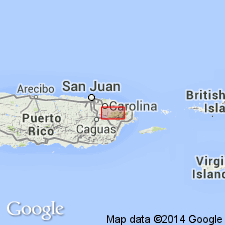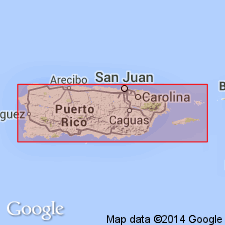
- Usage in publication:
-
- Barrazas Formation*
- Modifications:
-
- Named
- Biostratigraphic dating
- Dominant lithology:
-
- Sandstone
- Breccia
- Mudstone
- Volcaniclastics
- AAPG geologic province:
-
- Caribbean region
Summary:
The Barrazas Formation, here named, consists of marine-deposited calcareous volcanic sandstone and less abundant volcanic breccia and calcareous mudstone in the northwestern part of the Gurabo quad. Base is cut out by faults; conformably underlies the Hato Puerco Formation. Maximum thickness is 1,100 m. Age is Late Cretaceous (late Cenomanian) based on Foraminifera.
Source: GNU records (USGS DDS-6; Reston GNULEX).

- Usage in publication:
-
- Barrazas Formation*
- Modifications:
-
- Overview
- AAPG geologic province:
-
- Caribbean region
Summary:
The Barrazas Formation occurs in eastern Puerto Rico and consists of volcanic sandstone and volcaniclastic breccia and mudstone. Maximum estimated thickness is 1100 meters. The Barrazas is of Late Cretaceous age.
Source: GNU records (USGS DDS-6; Reston GNULEX).
For more information, please contact Nancy Stamm, Geologic Names Committee Secretary.
Asterisk (*) indicates published by U.S. Geological Survey authors.
"No current usage" (†) implies that a name has been abandoned or has fallen into disuse. Former usage and, if known, replacement name given in parentheses ( ).
Slash (/) indicates name conflicts with nomenclatural guidelines (CSN, 1933; ACSN, 1961, 1970; NACSN, 1983, 2005, 2021). May be explained within brackets ([ ]).

